THE WINTER OF OUR NORTHERN NATURE:

In this part: 'Hard midwinter/plants', part 1.
See also the wintering means of plants (e.g. different life forms)! and
the preparation of plants for the winter!

Hard midwinter/plants:
THE WINTER OF OUR NORTHERN NATURE:

In this part: 'Hard midwinter/plants', part 1.
See also the wintering means of plants (e.g. different life forms)! and
the preparation of plants for the winter!

Hard midwinter/plants:
• Many prefer a rather thick snow cover, some need none...
The plants’ relationship to the snow cover has often been presented by using a tripartition:
1) Chiomophobes = plants evasive of snow that tolerate snowless conditions in the winter.
2) Chiomophiles = plants preferential to snow that prefer a rather thick snow cover.
3) Chiomophores = plants having an ?indifferent? attitude towards snow cover. Compare the equivalent terms on animals!
Plants tolerating snow and plants evasive of snow (chionophobes = evasive of snow) prefer e.g. windy pale fells, rock walls or tussocks and rocks. Naturally, also trees tolerate snowless conditions (Although their roots usually require a snow cover).
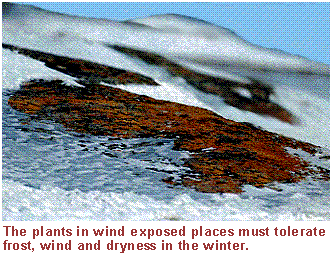
The uneven distribution of snow fall on the arctic hills clearly marks the vegetation. Only few species tolerating extreme dryness, coldness, windiness and thin humus layers survive on the wind exposed places and rock walls of arctic hills with very little snow. More information: Wind exposed places!
The species of wind exposed places and rock walls particularly so-called cushion plants have adapted well to dryness and coldness. More information: Cushion plants!
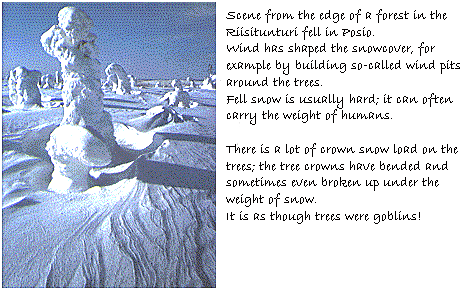
Chiomophiles = plants preferential to snow prefer a rather thick snow cover.
The wind in the gorges and hollows of the arctic hills piles up thick snowpacks, so-called snow beds that melt in the late summer. In the winter, they have approximately 1-2 meters of snow, in some spots even more.
Typically, the plants in snow beds have short growing seasons. However, in the winter plants growing in snow beds face a smaller threat of drying or freezing than the plants in wind exposed places. Instead, small mammals may eat the plant cover of the wind exposed places over the winter.
If the growing season is shorter than 2 months, practically all that grows in the snow beds are mosses. Particularly some liverwort species (e.g. Anthelia juratzkana) as well as some dicranum and haircap moss species tolerate the short growing season of the snow beds, and even a snow cover of several years!
If the growing season is approximately 3 months, some vascular plants also grow in the snow beds. For instance, cerastoides (Cerastium cerastioides), mountain cudweed (Gnaphalium supinum), biflora (Viola biflora), mountain sorrel (Oxyria digyna), hypnoides (Cassiope hypnoides), starry saxifrage (Saxifraga stellaris) sibbaldia (Sibbaldia procumbens), and dwarf willow (Salix herbacea) grow in the snow beds. In the snow beds with a fertile, calciferous substratum, species such as net-leaved willow (Salix reticulata), arctic willow (Salix polaris) and yellow mountain saxifrage can be found (Saxifraga aizoides).
If the thickness of the snow layer does not exceed one meter, the place cannot be called a snow bed, since the vegetation is dominated by ordinary bilberry brush. The blueberry dwarf shrubs require a rather good snow cover. On the contrary, lingonberry and crowberry are species that survive also in places with less snow, as, for instance, on tussocks. More information: the effect of snow cover on vegetation!
The thickness of snow cover varies also on swamps, fields and forests according to factors such as local topography and tree stand. The vegetation is also different, for instance, on tussocks and in dents, although snow is by no means the only factor affecting the variation. More information!
The ecological situation under the snow completely differs from the situation on the snowpack.
More information: Vegetation of bare fjeld tops!
• The cold tolerance varies according to the species, the plant part and the time...
Plants can be roughly divided into the following groups according to their tolerance of subzero temperatures: 1) Chilling sensitive species that die already in temperatures near zero degrees, 2) Frost sensitive species that cannot stand the forming of ice in the tissues, which causes them to die in a few degrees below zero, and 3) The species tolerating frost.
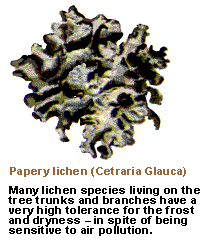 The
species that are the most chilling sensitive primarily come from areas
with a tropical climate. Some of them already die near zero degrees.The
species tolerating frost are classified as cool and cold climate vegetation. The
tree parts above the snowpack, as well as many epiphytic species of lichen have
a very high tolerance of coldness (as they do not have a snow cover!). Some of
them can survive even in the coldness of liquid nitrogen (-196°C), although this
is only possible in an extremely dry, hibernating state.
The
species that are the most chilling sensitive primarily come from areas
with a tropical climate. Some of them already die near zero degrees.The
species tolerating frost are classified as cool and cold climate vegetation. The
tree parts above the snowpack, as well as many epiphytic species of lichen have
a very high tolerance of coldness (as they do not have a snow cover!). Some of
them can survive even in the coldness of liquid nitrogen (-196°C), although this
is only possible in an extremely dry, hibernating state.
The tolerance of coldness (as well as its measuring techniques!) varies greatly. However, it can be seen from the chart below that also the northern vegetation includes both species tolerating the cold and species that are quite sensitive to the cold. Besides the species requiring a thick snow cover, many aquatic plants are equally rather sensitive to the cold.
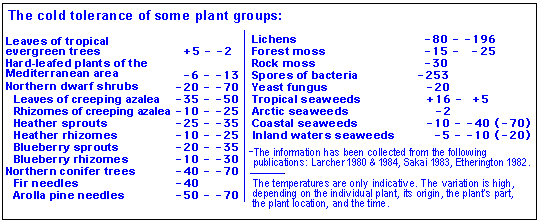
The plants and plant parts hibernating under snow are usually more sensitive to the cold than trees and the plants of wind exposed places. The ”warm” temperature under snow is stable throughout the winter, and therefore a high tolerance of coldness is not required. A snowpack of approximately half a meter isolates the plants well from the frost. The cold tolerance of many plants starts to weaken already in the midwinter, when the snow cover has become thick enough. See also blueberry's cold tolerance!
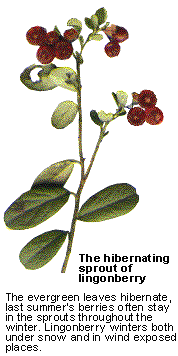
Different plant parts have a varying degree of cold tolerance.
Apical buds and flower buds get frostbitten more easily than the other plant parts. More information: The cold tolerance of buds!
The underground parts (roots and rootstocks) are more sensitive to the cold than the visible plant parts. Besides the snow cover, the humus layer is also a protection against the frost, whereas the cold tolerance of the underground parts does not have to be very high. For instance, the tree roots may not tolerate even 10 degrees warmer temperatures than the visible parts that are forced to experience the winter in all its hardness.
Plant parts such as seeds and spores as well as the living cells of the woody part of plants and cambium tissue of arborescent plants have a rather high cold tolerance. Seeds are usually very dry, which increases their cold tolerance. If the seeds of an annual plant are destroyed, the species will consequently disappear from the area in question. If the cambium of arborescent plant is destroyed, new growth will not be possible.
Cold tolerance is naturally the highest in the winter. In the summer, particularly during the high growing season, it is much lower. For instance, diapensia tolerates temperatures even as low as -60°C in midwinter, whereas in the summer, the same parts of the same species can tolerate ?only? temperatures above -10°C (see the picture!). Instead, blueberry dwarf shrubs, for instance, are quite sensitive to the cold, and require a rather thick snow cover. More information: The importance of snow!
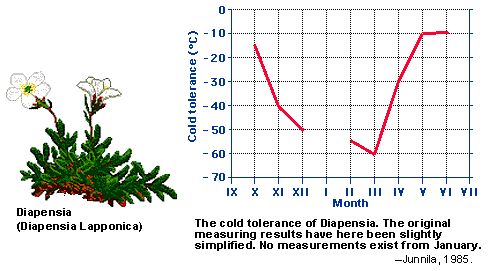
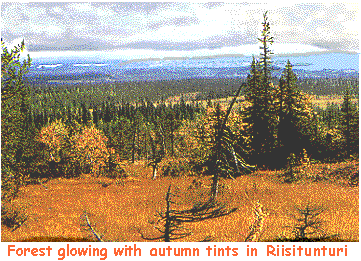
The cold tolerance of many species begins to increase already early in the late summer, however, what increases cold tolerance the most is the night frost of the fall. The weather conditions cause equally some changes to cold tolerance. During long periods of mild temperatures, cold tolerance can lower even in midwinter, however, the northern plants (especially the trees) do not easily attain the cold sensitive state typical for the summer!
Cold tolerance depends also on the origin of the individual plant or the population. More information: The cold tolerance of our coniferous trees! Trees transported to Lapland from south (such as birch trees or coniferous trees) may suffer damage or even die in the winter, as they have not had the opportunity to prepare themselves for the long and cold winter of Lapland. The same applies to numerous garden trees and bushes transported north from far south.
For other topics concerning nature go to Main menu!